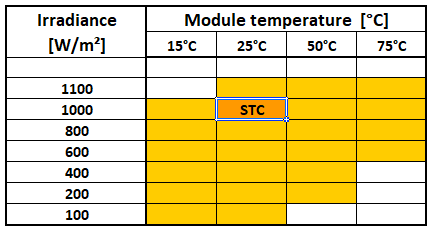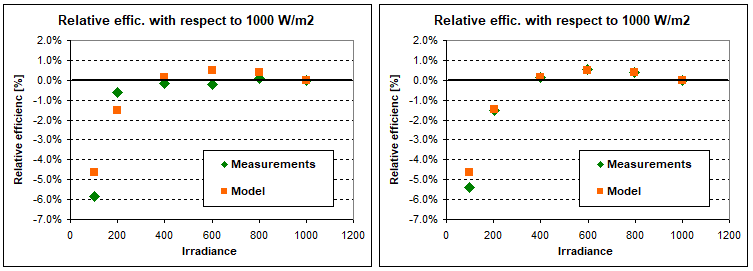Parameters besides Datasheets
Besides the basic electrical Isc, Voc, Impp and Vmpp data, the One-diode model implemented in PVsyst involves the following additional parameters, which usually are not given in data sheets:
The shunt resistance RShunt
The shunt resistance is defined according to a default value hypothesis chosen by PVsyst: Rshunt = Vmpp / (0.2 * (Isc - Impp))
Now with our long-term outside measurements at sun, on several technologies, we observed that the shunt resistance is exponentially increasing when the irradiance diminishes. This leads to 2 additional parameters:
- RshExp: the parameter of the exponential: we observes on all our measurements that this is quite constant value = 5.5) whatever the technology. This value should not be modified.
- Rsh0: the intercept of the Rshunt curve for Irradiance = 0: this was found to be very stable for all thin film technologies (about 12 times the Rshunt (1000 W/m²), and less for crystalline modules: 4 according to our experiments, around 8 for the usual indoor measurements of low-light performances performed by independent lags.
By the way with crystalline modules, the Shunt resistance is rather high, so that its effect on the Pmpp behaviour is weak. Moreover, if the low-light performance is not quite exact, this will be conterbalanced by the choice of the Rserie value for ensuring a specified low-light performance.
The series resistance RSerie
The Rserie appears to be the main parameter governing the low-light behaviour of the PV modules (i.e. the evolution of the low-light efficiency, relatively to the STC efficiency). Therefore we may use the relative efficiency under low-light conditions - now routinely measured by the certification laboratories acc. to IEC 61853 - for establishing the Rserie value.
By default, for crystalline modules PVsyst sets the Rserie in order to get a low-light relative efficiency of -3% @200 W/m2.
NB: This is sometimes not possible, i.e. the relative efficiency may not attain this value as the RSmax limits the possible Rserie. In these case we have to increase the Rshunt value, which increases the RSMax possible value.
If this is still not sufficient, we have to increase the specified Voc at STC (usually a very little bit). We observed that the Vmp/Voc ratio is usually much lower in the reports of measured values, than on the datasheets. We don't know how the manufacturers define their STC values for different power classes. We suspect that they reduce the Voc value in order to increase the Fill Factor.
RSerie other value
For the inclusion of modules in the PVsyst database: if the manufacturers provides a detailed report of measured data according to IEC 61853 from a third party laboratory, we analyze these results and evaluate the Rserie (and eventually Rshunt) for matching these measurements at best.
The muPmpp temperature coefficient
The temperature behaviour of the Maximum Power Point is normally a result of the one-diode model. However this rarely corresponds exactly to the specified value mentioned on the datasheets (often named "γ"), which is normally an explicitly measured value.
For matching the specified value, PVsyst applies a little linear correction (as function of the temperature) to the gamma value. This parameter is named "muGamma" and is adjusted by PVsyst in order to match the specified muPmpp value.
See also Temperatur behaviour corrections for further details.
Fit on 5 parameters using IEC 61853 data
Many test laboratories use to provide these 5 parameters specific to the PVsyst model (Rserie, RShunt, RshExt, Rsh0, muGamma) from their measurements.
The IEC standard requires the measurement of the I/V curve (Isc, Imp, Vmp, Voc) at 23 different Irradiance and temperature conditions:
They perform a 5-parameters fit over these 23 values.
We consider that such a fit cannot identify each of these parameter accurately:
- First, because the uncertainties on these measured values are not negligible.
- Secondly, the number of experimental points is not sufficient for adjusting 5 parameters in such a non-linear set of equations.
- Thirdly, the measurements are averages on 3 modules of same power, i.e. not "pure" measurements.
- Fourth, the results of the fit are highly dependent on the STC chosen values. The parameters are required not for this specific module (with these measured STC values), but for modules of different power classes, therefore different STC values as specified on the datasheets. The whole set of points has to be adjusted for each of these STC conditions, which are obviously not compatible with the STC measured values.
When analyzing the results of a same measurement but for several power classes, the parameters are usually completely different for each power class.
In fact it is illusory to wait a reliable fit from such data: the 5-parameters function is probably a highly varying function with minima and maxima between the reference points. And it is not extensible nor stable when slightly varying reference data.
NB: These fits usually lead to aberrant values. For example the RshExp is often of the order of 10 to 15. This means a very sharp exponential, with constant value up to very low irradiances, i.e. no exponential behaviour as function of irradiance anymore. This is in complete contradiction with all our measurements.
And on some measurements, the muPmpp result of the fit was significantly different than the muPmpp direct measurement by conventional method (i.e. numerous Pmpp measurements by continuously decreasing the module temperature). During the simulation this parameter is essential for a good evaluation of the temperature losses.
PVsyst methodology for filling the Database
We try to find a robust result, able to be extended to any "equivalent" module of different models or Power class.
We consider the basic parameters (RshExt, Rsh0, muGamma) as constant according to their standard values (and our general measurements). We only analyze the low-light behaviour at 25°C. For any module (of any power class), we choose the Rserie (and eventually increase Rshunt) in order to reproduce this low-light performance.
NB: This analysis is not always straightforward: we observe that the Isc is often not really linear with the irradiance. A deviation of 1% on the irradiance (obtained by filters) means a deviation of 1% on the relative efficiency.
Therefore we begin by analyzing the linearity of the Isc with the irradiance. This is supposed to be perfectly linear, so that we can correct the irradiance accordingly.
When doing this the rather erratic points on the measured relative efficiency curve become well aligned, and usually well matching the model.
Rough published measurements & Corrected Irradiance, as linear with the measured Isc

